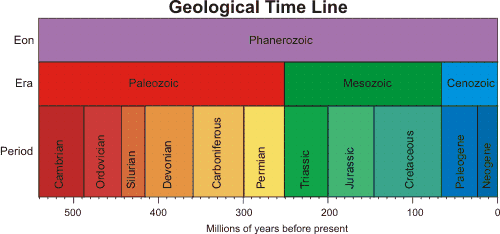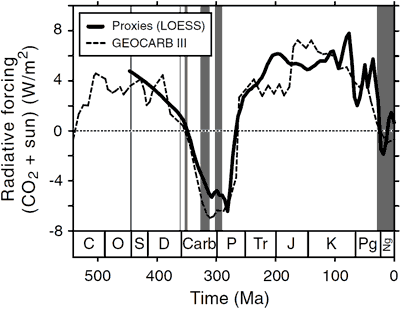High CO2 in the past, Part 2
Posted on 1 November 2009 by John Cook
Earlier this week, we saw that when you combine the effects of solar levels and CO2, you find good agreement with climate. However, there is an obvious objection to this argument. I even began to write an answer to the objection in that post but decided to save it for later. What surprised me was noone spotted it. Perhaps everyone was distracted by the ad hominem attack on Arrhenius while ironically, there was a legitimate scientific objection to be made. But before proceeding, I'll issue a challenge now to the reader. Go back and read CO2 was higher in the past before reading this post. Any skeptic worth his salt should spot what I'm talking about.
For starters, I find an overview of geological time scales helpful. It's not crucial to understanding but I like this stuff so bear with me. No skipping ahead! As geological time scales cover billions of years, geologists like to divide and subdivide Earth history into tinier, manageable parcels. The last 550 million years is known as the Phanazeroic Eon. This is divided into 3 eras - the Paleozoic, Mesozoic and Cenozoic. These eras are then divied up into periods. Examples of periods are the Cambrian, Ordovician and Jurassic. And periods are divided into epochs. We're currently in the Holocene epoch, begun around 11,000 years ago when the last ice age ended.

In case you didn't notice, scientists love to categorise, label and plot lots of charts and graphs. I'm not immune to this urge - just this week, I sorted skeptic arguments by taxonomy. But I digress. Royer 2005 takes a broad look at CO2 levels over the entire Phanerozoic Era. When combining the radiative forcing from CO2 and sun combined, he finds good agreement with climate. In Figure 2, the grey shaded areas are glacial periods. Generally, glacial periods coincide with times of low radiative forcing.

Figure 2: Combined radiative forcing from CO2 and sun through the Phanerozoic. The dark shaded bands correspond to glacial periods (Royer 2005)
However, there is one notable exception. Here is where the sharp eyed skeptic steps up to the plate. Late in the Ordovician period, the Earth experienced glacial conditions at a time of high CO2 levels. Observe the thin grey line around 443 to 445 million years ago. How could glacial conditions occur with such high CO2 values?
Royer 2005 assembled 490 proxy records of CO2 spanning the entire Phanerozoic period. The CO2 data covering the late Ordovician is sparse with one data point in the CO2 proxy record close to this period - it has a value of 5600 ppm. Given that solar output was around 4% lower than current levels, CO2 would need to fall to 3000 ppm to permit glacial conditions. Could CO2 levels have fallen this far? Given the low temporal resolution of the CO2 record, the data is not conclusive.
A newly released paper A major drop in seawater 87Sr/86Sr during the Middle Ordovician (Darriwilian): Links to volcanism and climate? (Young 2009) sheds more light on this question by examining strontium isotopes in the sediment record. Continental weathering removes CO2 from the atmosphere. The process also produces a particular isotope of strontium, washed down to the oceans via rivers. The ratio of strontium isotopes in sediment layers can be used to construct a proxy record of continental weathering activity.
What they found is that around the middle Ordovician, weatherability increased leading to an increased consumption of CO2. However, this was balanced by increased volcanic outgassing which added CO2 to the atmosphere. Around 446 million years ago, volcanic activity dropped while weathering remained high. This caused CO2 levels to fall below 3000 ppm which initiated cooling. What caused the late Ordovician glaciation? It turns out falling CO2 levels was the culprit.
To claim that "higher CO2 in the past disproves CO2 warming" is essentially a straw man argument. If climate scientists were claiming CO2 is the only driver of climate, then yes, high CO2 during glacial periods would be problematic. But any climate scientist will tell you CO2 is not the only driver of climate. When all forcings are considered, a close examination of past periods when CO2 was higher than today in fact confirm the influence of CO2 on climate.
UPDATE 6 Nov 2009: Science magazine have published an introductory summary to Young 2009: The Mountains That Froze the World (published 2 days after my post - I wish it had been 2 days earlier, would've saved me a lot of time!)































 Arguments
Arguments






























Also, Earth's albedo has shown little to no trend in recent years.
If I get the time, I would like to expand on studies of CO2 in the past as they only serve to confirm the influence CO2 has on climate.
The warming from doubling of CO2 is around 1.2°C (Lorius 1990) so you're not that far off. How does Roy Spencer arrive at "less than 1 deg C"? Unfortunately he doesn't cite how he arrives at that figure so I wouldn't know.
We are not just spectators - we are having an impact that is greater than the natural drivers of climate. This is why climate scientists talk about CO2 so much. It's not because CO2 is the only driver of climate. It's because CO2 is increasing so quickly, it's having a greater impact than other effects.
That CO2 is not the only driver of climate is important to keep in mind when considering past climate change when CO2 was much greater than current levels. You need to take into account other factors like changing solar levels. When you add up the various factors to calculate the net energy imbalance, what we observe in the past is consistent with our understanding of the CO2 greenhouse effect.
The ~4% value applies to the late Ordovician, the 5.5% to the beginning of the Phanerozoic. The article above gives an overview of geological time scales.